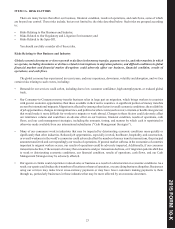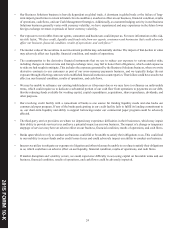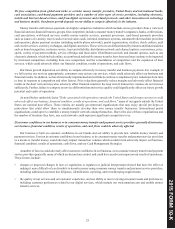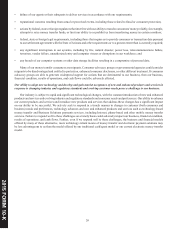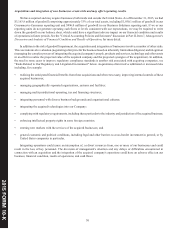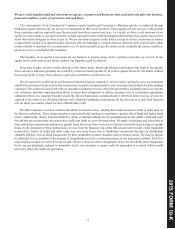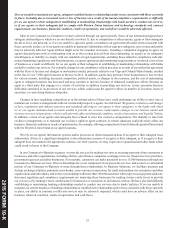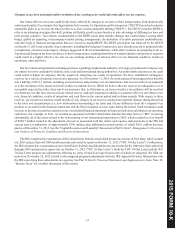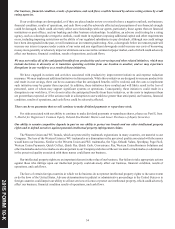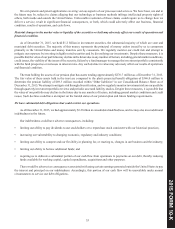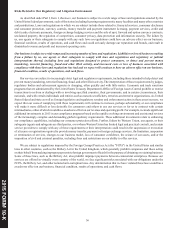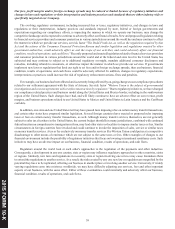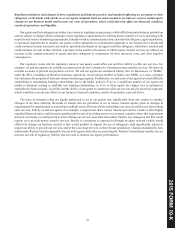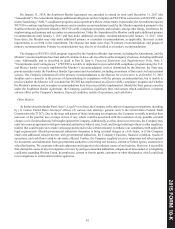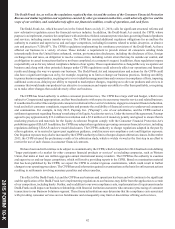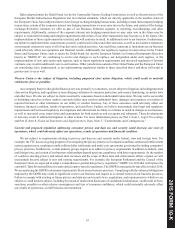Western Union 2015 Annual Report Download - page 135
Download and view the complete annual report
Please find page 135 of the 2015 Western Union annual report below. You can navigate through the pages in the report by either clicking on the pages listed below, or by using the keyword search tool below to find specific information within the annual report.
33
Changes in tax laws and unfavorable resolution of tax contingencies could adversely affect our tax expense.
Our future effective tax rates could be adversely affected by changes in tax laws or their interpretation, both domestically
and internationally. For example, the Organization for Economic Co-Operation and Development ("OECD") has asked countries
around the globe to act to prevent what it refers to as base erosion and profit shifting ("BEPS"). The OECD considers BEPS to
refer to tax planning strategies that shift, perhaps artificially, profits across borders to take advantage of differing tax laws and
rates among countries. Tax reforms recommended in the BEPS action plan include changes that would impact, among other
things, global tax reporting, intercompany transfer pricing arrangements, the definition of taxable permanent establishments,
and other legal or financial arrangements that are viewed as causing BEPS. The BEPS action plan was finalized by the OECD
on October 5, 2015 and a number of governments, including the European Commission, have already enacted or proposed rules
to implement, at least to some degree, changes suggested in the recommendations, while other countries are preparing to do so.
Any material change in tax laws or policies, or their interpretation, resulting from these or similar legislative proposals or inquiries
could result in a higher effective tax rate on our earnings and have an adverse effect on our financial condition, results of
operations, and cash flows.
Our tax returns and positions (including positions regarding jurisdictional authority of foreign governments to impose tax)
are subject to review and audit by federal, state, local and international taxing authorities. An unfavorable outcome to a tax audit
could result in higher tax expense, thereby negatively impacting our results of operations. We have established contingency
reserves for a variety of material, known tax exposures. As of December 31, 2015, the total amount of unrecognized tax benefits
was a liability of $113.1 million, including accrued interest and penalties, net of related items. Our reserves reflect our judgment
as to the resolution of the issues involved if subject to judicial review. While we believe that our reserves are adequate to cover
reasonably expected tax risks, there can be no assurance that, in all instances, an issue raised by a tax authority will be resolved
at a financial cost that does not exceed our related reserve, and such resolution could have a material effect on our effective tax
rate, financial condition, results of operations and cash flows in the current period and/or future periods. With respect to these
reserves, our income tax expense would include (i) any changes in tax reserves arising from material changes during the period
in the facts and circumstances (i.e. new information) surrounding a tax issue and (ii) any difference from the Company's tax
position as recorded in the financial statements and the final resolution of a tax issue during the period. Such resolution could
increase or decrease income tax expense in our consolidated financial statements in future periods and could impact our operating
cash flows. For example, in 2011, we reached an agreement with the United States Internal Revenue Service ("IRS") resolving
substantially all of the issues related to the restructuring of our international operations in 2003, which resulted in a tax benefit
of $204.7 million related to the adjustment of reserves associated with this matter and requires cash payments to the IRS and
various state tax authorities of approximately $190 million, plus additional accrued interest, of which $94.1 million has been
paid as of December 31, 2015. See the "Capital Resources and Liquidity" discussion in Part II, Item 7, Management's Discussion
and Analysis of Financial Condition and Results of Operations.
The IRS completed its examination of the United States federal consolidated income tax returns of First Data, which include
our 2005 and pre-Spin-off 2006 taxable periods and issued its report on October 31, 2012 ("FDC 30-Day Letter"). Furthermore,
the IRS completed its examination of our United States federal consolidated income tax returns for the 2006 post-Spin-off period
through 2009 and issued its report also on October 31, 2012 ("WU 30-Day Letter"). Both the FDC 30-Day Letter and the WU
30-Day Letter propose tax adjustments affecting us, some of which are agreed and some of which are unagreed. We filed our
protest on November 28, 2012 related to the unagreed proposed adjustments with the IRS Appeals Division. Discussions with
the IRS concerning these adjustments are ongoing. See Part II, Item 8, Financial Statements and Supplementary Data, Note 10,
"Income Taxes" for a further discussion of this matter.
201 FORM 10 K
5 -


